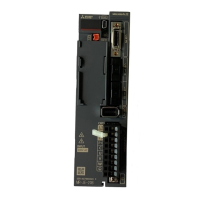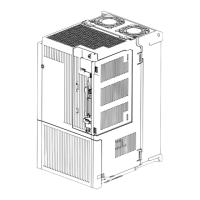10. CHARACTERISTICS
10 - 6
10.3.1 Dynamic brake operation
(1) Calculation of coasting distance
Fig. 10.3 shows the pattern in which the servo motor comes to a stop when the dynamic brake is
operated. Use equation 10.2 to calculate an approximate coasting distance to a stop. The dynamic
brake time constant τ varies with the servo motor and machine operation speeds. (Refer to (2) in this
section.)
A working part generally has a friction force. Therefore, actual coasting distance will be shorter than a
maximum coasting distance calculated with the following equation.
V
0
OFF
ON
Machine speed
t
e
Time
EM1 (Forced stop 1)
Dynamic brake
time constant τ
Fig. 10.3 Dynamic brake operation diagram
L
max
=
60
V
0
•
J
M
t
e
+1 +
J
L
··························································································· (10.2)
L
max
: Maximum coasting distance ······················································································ [mm]
V
0
: Machine's fast feed speed ····················································································· [mm/min]
J
M
: Moment of inertia of the servo motor ·································································· [× 10
-4
kg•m
2
]
J
L
: Load moment of inertia converted into equivalent value on servo motor shaft ·············· [× 10
-4
kg•m
2
]
τ: Dynamic brake time constant ···························································································· [s]
t
e
: Delay time of control section ···························································································· [s]
There is internal relay delay time of about 10 ms.
(2) Dynamic brake time constant
The following shows necessary dynamic brake time constant τ for equation 10.2.
Dynamic brake time
constant [ms]
Speed [r/min]
73
13
43
23
0
10
20
30
40
50
60
0 1000 2000 3000 4000 5000 6000
0
40
120
100
80
60
20
140
160
180
200
0 500 1000 1500 2000 2500 3000
102
52
202
302
152
Speed [r/min]
Dynamic brake time
constant [ms]
HG-KN series HG-SN series

